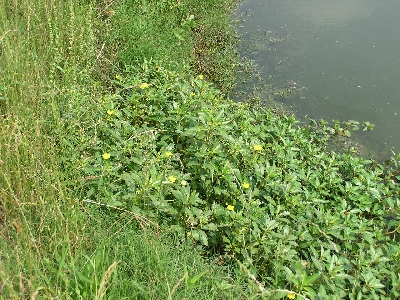Unveiling Nature’s Mischievous Dancer: Taming the Enigmatic Water Primrose
Understanding Water Primrose: Origin, Characteristics, and Impact
Water primrose is an invasive plant species that has become a major concern for water bodies and aquatic ecosystems around the world. Originating from South America, water primrose has found its way into many regions, causing significant damage to the native flora and fauna. Understanding the origin, characteristics, and impact of water primrose is crucial in effectively managing its proliferation and ultimately getting rid of this pesky aquatic invader.
Characterized by its vibrant yellow flowers and thick mats of floating leaves, water primrose can quickly overtake and outcompete native aquatic plants. It has the ability to form dense colonies, clogging waterways and impairing navigation. Additionally, this invasive plant can decrease oxygen levels in the water, disrupting the balance of the ecosystem and posing a threat to the survival of fish and other aquatic organisms.
Getting rid of water primrose can be a challenging task, but there are several methods that can be employed to control its spread. One effective method is manual removal, where the plants and their root systems are physically extracted from the water. This method is most successful when conducted early on before the plant has had a chance to establish extensive colonies. Another approach is the use of herbicides specifically formulated to target and kill water primrose. However, caution must be exercised when using herbicides to ensure they do not harm other aquatic life. Additionally, preventing the introduction and spread of water primrose is vital. It is important to clean boats, equipment, and fishing gear to avoid unintentionally transporting the plant to new bodies of water. Vigilance and community awareness play a crucial role in successfully managing the impact of water primrose.
The table below highlights some essential features and tips for effectively dealing with water primrose:
| Features and Tips | Description |
|---|---|
| Manual Removal | Physically extracting water primrose from the water |
| Herbicide Use | Using specific herbicides to target and eradicate water primrose |
| Clean Boats and Equipment | Preventing the unintentional spread of water primrose through proper cleaning practices |
By understanding the origin, characteristics, and impact of water primrose, as well as employing appropriate control methods, we can work towards effectively managing and reducing the presence of this invasive plant species. Taking proactive measures and implementing a combination of removal techniques will help protect our waterways and preserve the delicate balance of aquatic ecosystems.

Assessing and Managing Water Primrose Infestation: Effective Methods and Strategies
Water primrose infestation can be a major headache for those trying to maintain the health and beauty of their bodies of water. These invasive aquatic plants can quickly take over, choking out native species and disrupting ecosystems. However, there are effective methods and strategies to assess and manage water primrose infestations that can help restore balance to your aquatic environment.
One method for getting rid of water primrose is through physical removal. This can involve manually removing plants by hand, or using specialized equipment such as rakes or cutters to uproot or cut away the plants. It is important to ensure that all plant fragments are carefully removed to prevent regrowth. Additionally, introducing natural predators, such as certain species of fish or insects, can help control the spread of water primrose.
| Features or Tips | Description |
|---|---|
| Chemical Control | Using herbicides or algaecides can be an effective way to kill water primrose. However, caution should be exercised when using these chemicals to avoid harming desirable plant and animal species. |
| Biological Control | Introducing natural predators, like certain insects or fish, can help manage water primrose infestations by limiting their growth and spread. |
| Prevention | Regularly monitoring and taking preventive measures, such as maintaining proper water flow and reducing nutrient levels, can help prevent water primrose infestations from occurring or recurring. |

Preventive Measures: Tips and Techniques to Prevent Water Primrose Spread
Water primrose is an invasive aquatic plant that can rapidly take over water bodies, causing significant ecological damage. To combat its spread and prevent further infestation, it is crucial to implement preventive measures. Here are some effective tips and techniques to help you get rid of water primrose and keep it under control.
-
Identify and monitor: Regularly survey your water body to identify the presence of water primrose. Keep an eye out for its distinctive heart-shaped leaves and small yellow flowers. Early detection is key to preventing its spread.
-
Mechanical removal: For smaller infestations, manually remove water primrose by using a rake or a cutting tool. Be sure to remove the entire plant, including the roots. Dispose of the plant material away from the water body to prevent re-infestation.
-
Chemical control: In cases where mechanical removal is not feasible, consider using herbicides specifically designed for water primrose control. Consult with a local expert or aquatic specialist to determine the most suitable herbicide and application method for your situation.
-
Biological control: Explore the option of introducing natural predators, such as insects or fish species that feed on water primrose. These biological controls can help reduce the population of water primrose over time.
Table: Water Primrose Prevention Features or Tips
| Feature/Tips | Description |
|---|---|
| Regular monitoring | Consistently survey your water body to identify water primrose presence. |
| Mechanical removal | Physically remove water primrose using tools like rakes or cutting tools. |
| Chemical control | Use targeted herbicides for effective water primrose control. |
| Biological control | Introduce natural predators to feed on water primrose and reduce its population. |
Taking proactive measures to prevent water primrose spread is essential to protect the health and biodiversity of our water ecosystems. By identifying and monitoring the presence of water primrose, employing mechanical or chemical removal techniques, and considering biological control methods, we can effectively manage and mitigate the impact of this invasive species. Remember, early action is crucial in preventing further infestation and maintaining the ecological balance of our water bodies.
Eradicating Water Primrose: Recommended Removal Methods and Best Practices
If you’ve been battling the invasion of water primrose in your aquatic habitat, fret no more! We’ve gathered the most effective removal methods and best practices to help you eradicate this stubborn aquatic weed once and for all.
To successfully combat water primrose, consider implementing a combination of the following recommended methods:
- Manual Removal: One of the best ways to control water primrose is by physically removing the plants from the water. Regularly uproot the weed using a rake, pitchfork, or gloved hands, ensuring you remove as much of the roots as possible to prevent regrowth.
- Chemical Treatment: If manual removal alone isn’t sufficient, consider using aquatic herbicides that specifically target water primrose. Consult with a professional to identify the most suitable and environmentally friendly options, ensuring you follow all safety instructions and local regulations.
- Biological Control: Introducing specialized aquatic insects or fish species that feed on water primrose can be an effective long-term solution. Research which organisms are available in your region and seek guidance from experts to ensure proper implementation.
| Features | Tips |
|---|---|
| Fast-growing weed | Take immediate action when noticing water primrose to avoid extensive spreading. |
| Forms dense mats on water’s surface | Regularly monitor the area to prevent blocked water flow and oxygen depletion. |
| Yellow flowers | Identify the weed accurately to ensure targeted removal methods. |
Frequently Asked Questions
Q: What is water primrose and why do we need to get rid of it?
A: Water primrose, you sneaky little master of disguise, is a highly invasive aquatic plant that loves to take over our tranquil water bodies. So, why do we need to get rid of it? Well, this relentless green invader threatens native plant species, disrupts aquatic ecosystems, and hampers water flow. It’s time to say goodbye to this unwanted guest!
Q: How can I effectively banish water primrose from my water bodies?
A: Ah, the battle against the water primrose commences! Fear not, for there are a few ways to roll up your sleeves and triumph over this unwelcome intruder. You can get your hands dirty by manually removing it, or employ an army of herbicides, strategically applied, of course. Additionally, introducing plant-eating insects or even a combination of these methods can work wonders in restoring harmony to your aquatic paradise!
Q: Are there any preventive measures to keep water primrose at bay?
A: Prevention is the key to avoiding future catastrophes with water primrose. Implementing a vigilant watchman strategy can save you from a world of trouble. Simple steps, such as cleaning your boats and equipment thoroughly before entering new water bodies, will prevent the hitchhikers from settling in. Regular monitoring and early detection can nip potential water primrose invasions in the bud, ensuring the preservation of natural biodiversity. As we conclude this riveting expedition through the tangled waters of water primrose eradication, we hope that you have gained valuable insights, newfound knowledge, and perhaps even a touch of botanical prowess. Armed with the understanding of this invader’s deceptive beauty and menacing capabilities, your determination to reclaim nature’s balance is commendable.
Remember, dear readers, combating water primrose requires an unwavering commitment, an audacious spirit, and a dash of inventiveness. Mother Nature’s secret reserves have always rewarded those who dare to tread upon her untamed paths. So, as you embark on this adventure against the relentless water primrose, may you harness the forces of innovation, creativity, and perseverance in your noble quest.
Unyielding warriors of the watery realms, rejoice in the knowledge that you possess the tools to unravel the dominion of the water primrose. Armed with these strategies, from hand-pulling to chemical warfare, you can once again restore the natural beauty of your aquatic landscapes. Each step you take, each weed pulled, brings us closer to restoring the fragile equilibrium between flora and aquatic life.
Though the path ahead may be arduous, fear not, for your endeavors are not in vain. In your resolute quest to rid the aquatic realms of this invasive invader, you become bearers of hope, guardians of ecological harmony. It is through your collective efforts that we shall emerge triumphant, casting aside the shackles of the water primrose’s relentless domination.
So, gather your fellow nature enthusiasts, ignite your spirits with unwavering determination, and march forth from the shores of complacency into the marshes of reclamation. Let the symphony of splashing water and rustling leaves bear witness to your unwavering resolve as you reclaim nature’s territorial sanctity.
As you continue your valiant battles against the water primrose, remember to be vigilant in the face of adversity and adaptable in your strategies. Open your minds to Mother Nature’s wisdom, embrace the delicate balance of her aquatic realms, and the rewards of your labor shall manifest in the gentle sway of unadulterated native flora.
Farewell, brave souls, and may your journey against the water primrose be filled with glorious victories. With your commitment to preservation, our watery realms will flourish once more. Step forth with knowledge, purpose, and fortitude, for now is the time to rid our waters of the audacious water primrose and reclaim nature’s bountiful embrace.
- When to Put Weed and Feed on Lawn in Michigan - October 16, 2023
- When to Fertilize Potatoes Plants - October 16, 2023
- Can You Plant Clover in the Spring - October 16, 2023
Contents
- 1 Understanding Water Primrose: Origin, Characteristics, and Impact
- 2 Assessing and Managing Water Primrose Infestation: Effective Methods and Strategies
- 3 Preventive Measures: Tips and Techniques to Prevent Water Primrose Spread
- 4 Eradicating Water Primrose: Recommended Removal Methods and Best Practices
- 5 Frequently Asked Questions

